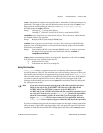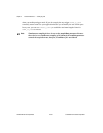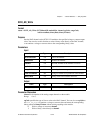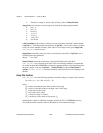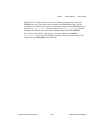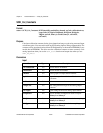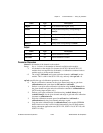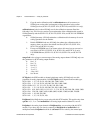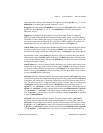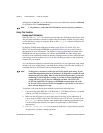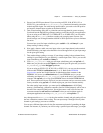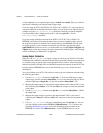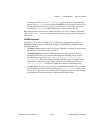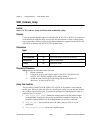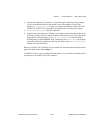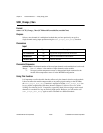
Chapter 2 Function Reference — SCXI_Cal_Constants
©
National Instruments Corporation 2-325 NI-DAQ FRM for PC Compatibles
range and polarity settings for this channel. This applies only when opCode = 0, 1, 2, or 3 and
moduleSlot is an analog input module. Otherwise, set to 0.
DAQgain is the gain setting for DAQchan. It is used to scale calConst1 (binary offset). This
applies only when opCode = 0, 1, 2, or 3 and moduleSlot is an analog input module.
Otherwise, set to 0.
TBgain is the terminal block gain applied to the SCXI channel, if any. Currently, the
SCXI-1327 terminal block is the only terminal block that applies gain to your SCXI channels.
The SCXI-1327 has switches that you use to select either a gain of 1.0 or a gain of 0.01. You
can use this terminal block with an SCXI-1120, SCXI-1120D, or SCXI-1121 module. For
terminal blocks that do not apply gain to your SCXI channels, set TBgain =1.0.
scaled1, binary1 is the measured input value/binary pair you have taken for the given channel
and range or gain. If the module is analog output, scaled1 is the voltage or current you
measured at the output channel after writing the binary value binary1 to the output channel.
If the module is analog input, binary1 is the binary value you read from the input channel
with a known voltage of scaled1 applied at the input. The binary1 parameter is floating point,
so you can take multiple binary readings from scaled1 and average them to be more accurate
and reduce the effects of noise.
scaled2, binary2 is a second measured input value/binary pair you have taken for the given
channel and range or gain. If the module is analog output, scaled2 is the voltage or current
you measured when NI-DAQ wrote the binary value binary2 to the output channel. If the
module is analog input, binary2 is the binary reading from the input channel with a known
voltage of scaled2 applied at the input.
calConst1 is the first calibration constant. For analog output modules, calConst1 is the binary
value that will generate the voltage/current/frequency. For analog input modules, calConst1
is the binary zero offset; that is, the binary reading that would result from an input value of
zero. The offset is stored as a voltage and must be scaled to a binary value. It is scaled based
on DAQgain and the current configuration of DAQchan (polarity and input range). If
opCode = 1 or 2, calConst1 is a return value calculated from the input value/binary pairs. If
opCode = 0, calConst1 is a return constant retrieved from the calibrationArea. If opCode
= 0 and channel = -2, calConst1 is the actual voltage excitation value returned in units of
volts. If opCode = 3, you should pass your first calibration constant in calConst1 for NI-DAQ
to store in calibrationArea.
calConst2 is the second calibration constant. For analog output modules, calConst2 is
the binary value that generates the voltage/current/frequency. For analog input modules,
calConst2 is the gain adjust factor; that is, the ratio of the real gain to the ideal gain setting.
If opCode = 1 or 2, calConst2 is a return value calculated from the input value/binary pairs.
If opCode = 0, calConst2 is a return constant retrieved from the calibrationArea. If opCode
= 0 and channel = -2, calConst2 is the actual current excitation value returned in units of



